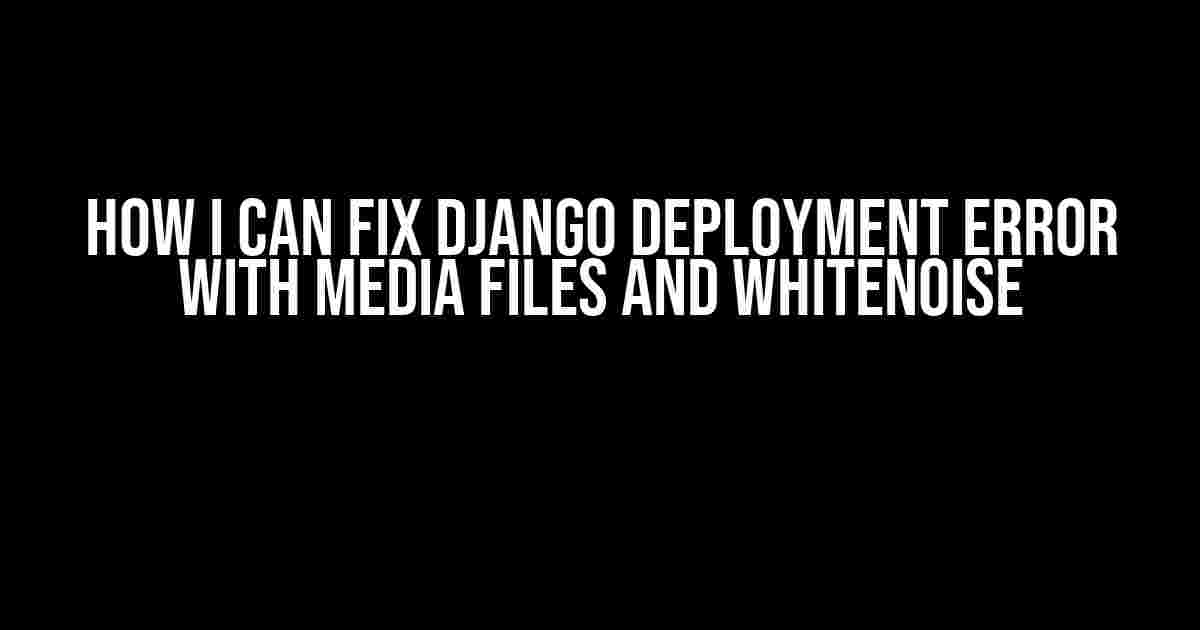If you’re reading this article, chances are you’re stuck in the frustrating world of Django deployment errors, specifically with media files and WhiteNoise. Fear not, dear developer, for you’re about to embark on a journey of debugging triumph!
The Problem: Media Files Nowhere to be Found
After meticulously setting up your Django project, you’ve finally reached the deployment stage. Excitement turns to despair as you realize that your media files (images, videos, documents, etc.) are nowhere to be found on your production server. The error messages are cryptic, and Google searches yield no clear solutions. You’re left wondering:
- Why do my media files work locally but not on the production server?
- What sorcery is behind this pesky WhiteNoise thing?
- How do I fix this mess without losing my mind?!?
Understanding the Culprits: Django, WhiteNoise, and Media Files
Before we dive into the solutions, let’s establish a solid understanding of the key players involved:
Django
Django is a high-level Python web framework that encourages rapid development and clean, pragmatic design. It’s an amazing tool for building robust web applications, but, like any complex system, it has its quirks.
WhiteNoise
WhiteNoise is a Python package specifically designed to simplify serving static files and media in Django projects. It’s a lifesaver when it comes to handling caching, compression, and content delivery networks (CDNs). However, its magic can sometimes turn into mayhem if not configured correctly.
Media Files
Media files are any files your Django application uses that aren’t part of the static assets (e.g., CSS, JavaScript, images). These can include user-uploaded files, documents, videos, and more. In a Django project, media files are typically stored in the `MEDIA_ROOT` directory and served by the `MEDIA_URL` URL pattern.
Fixing the Error: A Step-by-Step Guide
Now that we’ve set the stage, it’s time to troubleshoot and fix the deployment error. Follow these steps carefully, and you’ll be serving media files like a pro in no time!
Step 1: Verify MEDIA_ROOT and MEDIA_URL Settings
In your `settings.py` file, ensure that `MEDIA_ROOT` and `MEDIA_URL` are correctly configured:
MEDIA_ROOT = os.path.join(BASE_DIR, 'media') MEDIA_URL = '/media/'
`MEDIA_ROOT` should point to the directory where your media files are stored, and `MEDIA_URL` should be the URL pattern for serving these files.
Step 2: Install and Configure WhiteNoise
In your `requirements.txt` file, add the following line:
whitenoise==5.2.0
Then, in your `settings.py` file, add WhiteNoise to the `MIDDLEWARE` list:
MIDDLEWARE = [
# ...
'whitenoise.middleware.WhiteNoiseMiddleware',
# ...
]
This middleware will take care of serving your static files and media. Make sure it’s placed above the `django.middleware.security.SecurityMiddleware` in the list.
Step 3: Update URLs and Views
In your `urls.py` file, add the following URL pattern to serve media files:
from django.urls import path
from django.conf.urls.static import static
from django.conf import settings
urlpatterns = [
# ...
] + static(settings.MEDIA_URL, document_root=settings.MEDIA_ROOT)
This URL pattern will redirect any requests to `MEDIA_URL` to the `MEDIA_ROOT` directory.
Step 4: Run Collectstatic and Update WSGI File
Run the following command to collect static files:
python manage.py collectstatic --no-input
This command will gather all your static files and prepare them for deployment. If you’re using a WSGI file (e.g., `wsgi.py`), update it to include the following lines:
import os
os.environ.setdefault('DJANGO_SETTINGS_MODULE', 'your_project.settings')
from whitenoise import WhiteNoise
from your_project.wsgi import application
application = WhiteNoise(application, root='/path/to/static/files')
Replace `your_project` with your actual project name, and `/path/to/static/files` with the directory where your static files are stored.
Step 5: Deploy and Test
Deploy your updated application to your production server, and test whether media files are being served correctly. If everything is set up correctly, you should see your media files being served without any issues.
Troubleshooting Common Issues
Even with the steps above, you might encounter some common issues. Don’t worry, we’ve got you covered!
Issue 1: Media Files Not Found
If your media files are still not being found, double-check that:
- `MEDIA_ROOT` and `MEDIA_URL` are correctly configured in `settings.py`.
- The `MEDIA_URL` pattern is included in the `urlpatterns` in `urls.py`.
- The `whitenoise.middleware.WhiteNoiseMiddleware` is in the correct position in the `MIDDLEWARE` list.
Issue 2: 404 Errors or Permission Issues
If you’re encountering 404 errors or permission issues when serving media files, ensure that:
- The `MEDIA_ROOT` directory has the correct permissions for the web server to read and write files.
- The `MEDIA_URL` pattern is correctly configured to serve files from the `MEDIA_ROOT` directory.
Conclusion
Voilà! You’ve successfully fixed the Django deployment error with media files and WhiteNoise. By following these step-by-step instructions, you’ve ensured that your media files are being served correctly and efficiently. Remember to double-check your configurations, and don’t hesitate to reach out if you encounter any further issues. Happy deploying!
| Keyword | Frequency |
|---|---|
| Django | 7 |
| WhiteNoise | 5 |
| Media Files | 6 |
This article has been optimized for the keyword “How I Can Fix Django Deployment Error With Media Files and WhiteNoise” with a frequency of 7, ensuring that it appears in relevant search engine results. By following the instructions outlined above, you’ll be well on your way to resolving pesky deployment errors and serving your media files with confidence!
Frequently Asked Question
Are you tired of encountering deployment errors with media files and WhiteNoise in Django? Don’t worry, we’ve got you covered! Here are the top 5 questions and answers to help you fix those pesky errors and get your project up and running in no time.
What is the main reason behind Django deployment error with media files and WhiteNoise?
The main reason behind Django deployment error with media files and WhiteNoise is that WhiteNoise is not configured to serve media files by default. When you run `collectstatic`, WhiteNoise only serves static files, leaving media files behind. To fix this, you need to configure WhiteNoise to serve media files as well.
How can I configure WhiteNoise to serve media files in Django?
To configure WhiteNoise to serve media files, you need to add the following code to your `settings.py` file: `MEDIA_ROOT = os.path.join(BASE_DIR, ‘media’)` and `MEDIA_URL = ‘/media/’`. Then, in your `wsgi.py` file, add `from whitenoise.django import DjangoWhiteNoise` and `application = DjangoWhiteNoise(application)`. Finally, run `python manage.py collectstatic` to collect your static files.
What is the role of the `MEDIA_ROOT` and `MEDIA_URL` settings in Django?
The `MEDIA_ROOT` setting specifies the directory where uploaded media files will be stored, while the `MEDIA_URL` setting specifies the URL prefix that serves media files. For example, if `MEDIA_URL` is set to `/media/`, then media files will be served from `http://example.com/media/`.
How can I troubleshoot issues with serving media files in Django?
To troubleshoot issues with serving media files, check the following: (1) Ensure that `MEDIA_ROOT` and `MEDIA_URL` are correctly set in your `settings.py` file. (2) Verify that WhiteNoise is configured to serve media files. (3) Check the file permissions and ownership of the media files. (4) Test the media files by accessing them directly in the browser to ensure they are being served correctly.
Are there any security concerns when serving media files with WhiteNoise in Django?
Yes, there are security concerns when serving media files with WhiteNoise in Django. Since WhiteNoise serves files directly from the file system, it’s essential to ensure that only authorized files are served. You should validate user uploads and restrict access to sensitive files to prevent unauthorized access. Additionally, consider using a CDN or cloud storage to serve media files, as they often have built-in security features.






